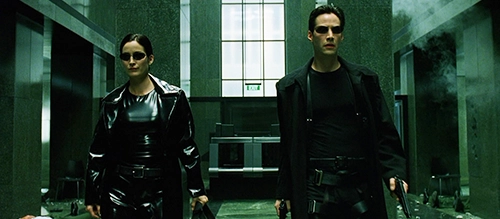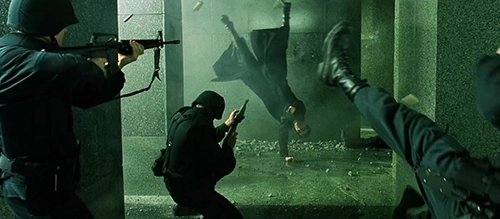‘The Matrix’ at 25 – Review

The Matrix (1999)
Director: Lana Wachowski, Lilly Wachowski
Screenwriters: Lana Wachowski, Lilly Wachowski
Starring: Keanu Reeves, Laurence Fishburne, Carrie-Anne Moss, Hugo Weaving, Gloria Foster, Joe Pantoliano, Marcus Chong, Matt Doran, Julian Arahanga, Anthony Ray Parker, Belinda McClory
What is there to be write about The Matrix that hasn’t yet been written? The film is one of those rare texts that has entered the cultural consciousness more on the level of myth than of actual cinema; it is an idea, a concept, rather than an attempt to blend anime-influenced cyberpunk with Buddhism and French postmodernist philosophy. It is on the level of Greek mythology and the Norse gods. It’s a testament to the skill of the Wachowskis that it works even remotely well, let alone goes on to create a new category of special effects tricks, have dozens of textbooks on its theory, and make long black trench coats and shades an instant trademark.
For those who have been living under a rock (or perhaps in a Platonic cave), a refresher of the plotline. Mr Anderson (Keanu Reeves) works by day at a software company, but by night is a computer hacker under the alias of Neo. Evading a legion of suit-wearing secret agents (led by Hugo Weaving’s Agent Smith), he is led to Trinity and Morpheus (Carrie-Anne Moss and Laurence Fishburne) in order to answer the all important question: “What is The Matrix?” He eventually becomes embroiled in a fight for the existence of the human race, dodges bullets, and gets his hands on guns. Lots of guns.
The idea that this was somehow groundbreaking and that nobody had ever done anything like what The Matrix did is not entirely the case. David Cronenberg’s Existenz, made and released around the same time, also features a virtual reality split. The Wachowskis have been on record to discuss the influence of Ghost in the Shell (1995), Akira (1988), and novels such as “Snow Crash (1992) and “Neuromancer” (1984) – although they borrowed the idea of a computer-generated world called The Matrix from “Neuromancer”, the term applied in science-fiction to something created by computers and wasn’t a purely Gibson invention, as there was a novel titled “The Matrix” by Jo Bannister in 1981 involving a sentient computer program with the name. Their heavy drawing on the postmodernist text “Simulacra and Simulation” from Jean Baudrillard is also apparent; Neo hides his software disks in a hollowed-out version of the book at the beginning, and large swathes of the dialogue, including Morpheus’s ‘desert of the real’ is lifted straight from the book. The book was also required reading for the cast and crew.
What was new, however, was combining everything together in a film that was palatable, and marketed, for mainstream Hollywood audiences, combining the Hollywood action film with Hong Kong martial arts films, and then putting a massive budget into it. It is the specific circumstances and combination of ideas, with its presentation, that was new, especially to 99% of the average cinemagoer in the west. The ingredients were available, but the dish is radical.
And what a treat audiences were given when they went almost blind into the theatres. Directed to within an inch of the film’s life, every shot is carefully crafted; sumptuous moments with iconic framing creating utterly breathtaking visuals. The script honed over nearly five years of preparation before going into pre-production means there’s not an inch of fat on it. Even off-the-cuff lines are instantly recognisable and quoted by the masses without losing some of their naturalness and potency.

The main cast put in the performances of their lives, and it’s a testament that despite their illustrious careers there’s a large part of the populous who, when asked where they know Reeves, Fishburne, Moss, and Weaving from, will instantly say The Matrix. Keanu Reeves as Neo might not be the obvious choice for the role (Will Smith is only one actor who was offered the part but rejected it), but his wide-eyed innocence visually changes throughout his arc, and by the end is every bit the cyberpunk hero he needs to be. Laurence Fishburne has never given more gravitas to a role, and Hugo Weaving has never been more sinister in one of the most chilling roles in modern cinema. The supporting cast also bring their top A-game, leaving us with a roster of incredible performances for a lifetime.
Through a mix of incredible visuals (including the slow-motion ‘bullet time’ effect, parodied so many times in films afterwards), wonderful cinematography by Bill Pope, music from Don Davis, and all the other crew in the art departments, we are offered a vibrant yet chilling world to immerse ourselves in. The genius to contrast the green of the matrix world with the cool blue of the Nebuchadnezzar’s world keeps a visual aid intact, which allows a complex plot to be perfectly understandable upon first viewing. The Matrix’s key trade is in giving complex concepts and ideas enough simplification to be palatable to everyone, and all aspects of filmmaking come together to achieve this in flawless unison.
It isn’t completely perfect a film. The love story between Neo and Trinity is never properly set up, and a few small moments seem put in simply to establish an ending that is Hollywood enough to be needed by producers but out of place with the storyline presented. But this doesn’t get in the way of what is an incredible achievement. To be able to create this in the midst of the 90s Hollywood machine is a magnificent and rare thing. It’s a beautiful match of head and heart, of thrills and thought, and that it stands up twenty-five years later is glorious.
Time will only go on to show just how much The Matrix changed not only film, but the world. “What is The Matrix?” Answer: a landmark in culture. Its aftershocks, even without the sequels, are still being felt today.
Score: 23/24

